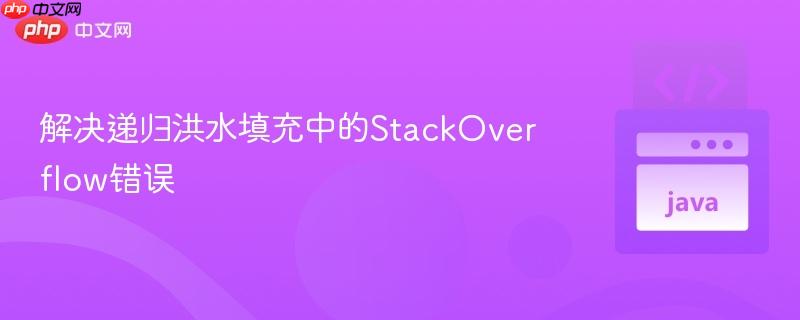
递归实现的洪水填充算法在处理大型网格时,由于函数调用栈深度过大,极易引发stackoverflowerror。本文将深入分析其原因,并通过提供迭代式解决方案,如使用显式栈或队列模拟深度优先搜索(dfs)或广度优先搜索(bfs),有效避免栈溢出问题,同时保持算法的正确性和效率,适用于生产环境中的大规模图像处理或图遍历场景。
洪水填充(Flood Fill)是一种经典的图遍历算法,常用于图像处理中填充连通区域。其核心思想是从一个起始点开始,递归地访问所有与其颜色相同且相邻的像素点,并将其颜色改变或标记。以下是一个典型的递归洪水填充实现示例:
public class FloodFillRecursive {
private static boolean[][] went; // 记录访问过的坐标
private static int[][] grid; // 网格数据,1表示可填充区域
// 假设grid和went已初始化,且went的边界与grid相同
// grid尺寸例如 102x102 (包含边界检查的额外空间)
public static int flood(int x, int y) {
// 边界检查和已访问检查
if (x < 0 || y < 0 || x >= grid.length || y >= grid[0].length || went[x][y]) {
return 0;
}
went[x][y] = true; // 标记为已访问
if (grid[x][y] == 1) { // 如果当前点是可填充区域
// System.out.println("Visiting: " + x + ", " + y); // 调试输出
int result = 1; // 计数当前点
// 递归访问四个邻居
result += flood(x + 1, y);
result += flood(x, y + 1);
result += flood(x - 1, y);
result += flood(x, y - 1);
return result;
}
return 0; // 当前点不可填充
}
public static void main(String[] args) {
// 示例:一个 10x10 的网格
int size = 10;
grid = new int[size][size];
went = new boolean[size][size];
// 填充一个简单的可填充区域
for (int i = 0; i < size; i++) {
for (int j = 0; j < size; j++) {
grid[i][j] = 1;
}
}
System.out.println("Starting recursive flood fill...");
try {
int filledCount = flood(0, 0);
System.out.println("Filled cells: " + filledCount);
} catch (StackOverflowError e) {
System.err.println("Error: StackOverflowError occurred!");
System.err.println("This typically happens with large grids due to deep recursion.");
}
// 尝试一个更大的网格(可能导致StackOverflow)
System.out.println("\nTesting with a larger grid (e.g., 100x100)...");
int largeSize = 100; // 尝试 100x100
grid = new int[largeSize][largeSize];
went = new boolean[largeSize][largeSize];
for (int i = 0; i < largeSize; i++) {
for (int j = 0; j < largeSize; j++) {
grid[i][j] = 1;
}
}
try {
int filledCountLarge = flood(0, 0);
System.out.println("Filled cells in large grid: " + filledCountLarge);
} catch (StackOverflowError e) {
System.err.println("Error: StackOverflowError occurred with large grid!");
System.err.println("Reason: The recursive call stack became too deep.");
}
}
}上述递归实现虽然简洁直观,但其核心问题在于每次函数调用都会在程序的调用栈(Call Stack)中创建一个新的栈帧。在处理大型网格(例如100x100)时,如果填充区域是连续的,例如从(0,0)开始,算法可能会沿着一条路径一直递归到(99,99)才开始返回。这意味着在最坏情况下,调用栈的深度可能达到网格中元素的总数(100 * 100 = 10000),这远远超出了JVM默认的栈大小限制,从而导致 StackOverflowError。
JVM的默认栈大小通常为几百KB到1MB不等,每个栈帧的大小取决于函数参数、局部变量以及返回地址等。当递归深度过大时,即使每个栈帧很小,累积起来也会迅速耗尽栈空间。
为了避免 StackOverflowError,我们应该将递归算法转换为迭代式算法。这通常通过使用一个显式的栈(Stack)或队列(Queue)来模拟递归调用的行为。
通过使用 java.util.Stack 来存储待访问的坐标,我们可以模拟递归的深度优先搜索行为。
import java.util.Stack;
public class FloodFillIterativeDFS {
private static boolean[][] went;
private static int[][] grid;
// 定义一个简单的坐标类
static class Point {
int x, y;
Point(int x, int y) {
this.x = x;
this.y = y;
}
}
public static int floodIterativeDFS(int startX, int startY) {
// 边界检查
if (startX < 0 || startY < 0 || startX >= grid.length || startY >= grid[0].length || went[startX][startY] || grid[startX][startY] != 1) {
return 0;
}
Stack<Point> stack = new Stack<>();
stack.push(new Point(startX, startY));
went[startX][startY] = true;
int filledCount = 0;
int[] dx = {0, 0, 1, -1}; // x方向的偏移量
int[] dy = {1, -1, 0, 0}; // y方向的偏移量
while (!stack.isEmpty()) {
Point current = stack.pop();
filledCount++;
// 检查四个邻居
for (int i = 0; i < 4; i++) {
int nx = current.x + dx[i];
int ny = current.y + dy[i];
// 边界检查、是否已访问、是否是可填充区域
if (nx >= 0 && nx < grid.length && ny >= 0 && ny < grid[0].length &&
!went[nx][ny] && grid[nx][ny] == 1) {
went[nx][ny] = true; // 标记为已访问
stack.push(new Point(nx, ny)); // 将邻居加入栈中
}
}
}
return filledCount;
}
public static void main(String[] args) {
// 示例:一个 10x10 的网格
int size = 10;
grid = new int[size][size];
went = new boolean[size][size];
for (int i = 0; i < size; i++) {
for (int j = 0; j < size; j++) {
grid[i][j] = 1;
}
}
System.out.println("Starting iterative DFS flood fill (10x10)...");
int filledCountDFS = floodIterativeDFS(0, 0);
System.out.println("Filled cells: " + filledCountDFS);
// 尝试一个更大的网格(例如 100x100)
System.out.println("\nTesting with a larger grid (e.g., 100x100)...");
int largeSize = 100;
grid = new int[largeSize][largeSize];
went = new boolean[largeSize][largeSize];
for (int i = 0; i < largeSize; i++) {
for (int j = 0; j < largeSize; j++) {
grid[i][j] = 1;
}
}
int filledCountLargeDFS = floodIterativeDFS(0, 0);
System.out.println("Filled cells in large grid: " + filledCountLargeDFS); // 不会发生StackOverflow
}
}如果需要按层级顺序访问或寻找最短路径,可以使用 java.util.Queue(通常是 LinkedList 的实例)来实现广度优先搜索。
import java.util.LinkedList;
import java.util.Queue;
public class FloodFillIterativeBFS {
private static boolean[][] went;
private static int[][] grid;
static class Point {
int x, y;
Point(int x, int y) {
this.x = x;
this.y = y;
}
}
public static int floodIterativeBFS(int startX, int startY) {
// 边界检查
if (startX < 0 || startY < 0 || startX >= grid.length || startY >= grid[0].length || went[startX][startY] || grid[startX][startY] != 1) {
return 0;
}
Queue<Point> queue = new LinkedList<>();
queue.offer(new Point(startX, startY));
went[startX][startY] = true;
int filledCount = 0;
int[] dx = {0, 0, 1, -1};
int[] dy = {1, -1, 0, 0};
while (!queue.isEmpty()) {
Point current = queue.poll();
filledCount++;
for (int i = 0; i < 4; i++) {
int nx = current.x + dx[i];
int ny = current.y + dy[i];
if (nx >= 0 && nx < grid.length && ny >= 0 && ny < grid[0].length &&
!went[nx][ny] && grid[nx][ny] == 1) {
went[nx][ny] = true;
queue.offer(new Point(nx, ny));
}
}
}
return filledCount;
}
public static void main(String[] args) {
// 示例:一个 10x10 的网格
int size = 10;
grid = new int[size][size];
went = new boolean[size][size];
for (int i = 0; i < size; i++) {
for (int j = 0; j < size; j++) {
grid[i][j] = 1;
}
}
System.out.println("Starting iterative BFS flood fill (10x10)...");
int filledCountBFS = floodIterativeBFS(0, 0);
System.out.println("Filled cells: " + filledCountBFS);
// 尝试一个更大的网格(例如 100x100)
System.out.println("\nTesting with a larger grid (e.g., 100x100)...");
int largeSize = 100;
grid = new int[largeSize][largeSize];
went = new boolean[largeSize][largeSize];
for (int i = 0; i < largeSize; i++) {
for (int j = 0; j < largeSize; j++) {
grid[i][j] = 1;
}
}
int filledCountLargeBFS = floodIterativeBFS(0, 0);
System.out.println("Filled cells in large grid: " + filledCountLargeBFS); // 不会发生StackOverflow
}
}综上所述,当处理大规模数据结构(如大型网格)时,将递归算法转换为迭代式算法是避免 StackOverflowError 的标准且健壮的做法。通过使用显式栈或队列,我们可以有效地管理内存,并确保算法在各种规模下都能稳定运行。
以上就是解决递归洪水填充中的StackOverflow错误的详细内容,更多请关注php中文网其它相关文章!

每个人都需要一台速度更快、更稳定的 PC。随着时间的推移,垃圾文件、旧注册表数据和不必要的后台进程会占用资源并降低性能。幸运的是,许多工具可以让 Windows 保持平稳运行。

Copyright 2014-2025 https://www.php.cn/ All Rights Reserved | php.cn | 湘ICP备2023035733号